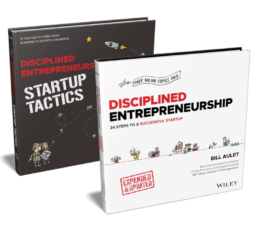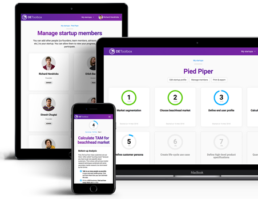The Disciplined Entrepreneurship Toolbox
Stay ahead by using the 24 steps together with your team, mentors, and investors.
Sign up for our newsletter
Ever since reading Disciplined Entrepreneurship for the first time in 2013, the Disciplined Entrepreneurship methodology has been a foundational element to our entrepreneurship programs at Arrowhead Center at New Mexico State University (NMSU). Studio G, the largest student entrepreneurship program in New Mexico, has grown from 3 members in 2013 to more than 1,100 active ventures and 19 Studio G Sites at colleges and universities in New Mexico and Texas. In 2019, Studio G was ranked one of the Top 20 University Business Incubators in the world by UBI Global.
Disciplined Entrepreneurship remains a critical piece to this success. We have experimented with numerous teaching approaches during Studio G’s development. Through the rollout of our Studio G program, we have learned the importance of flexible program delivery. In order to reach and support the maximum number of entrepreneurs, we have found it is important to create a flexible program for teaching entrepreneurship that can be adapted to entrepreneurs in a wide variety of life circumstances. This article will review some of the approaches we have taken to teach entrepreneurship using Disciplined Entrepreneurship and the principles we have used to design these programs.
In designing the curriculum for entrepreneurs, we had many discussions about what should be required, what should be optional, what adds value, what doesn’t, and so on. To make design decisions about the program, it was important for us to develop a set of principles for supporting entrepreneurs. This defined our support approach, based on our experience and best practices we have learned from methodologies like Disciplined Entrepreneurship and Lean Launchpad.
We currently have 19 principles we review with all employees, student employees, and advisers, such as, “3. Always add value.”, “5. Don’t be a critic. The market is the judge, not you.” and “7. Never blame the client. Always reflect on what you can do to improve.” This has been very helpful to provide consistency to our approach for helping advisers. Since they are principles, it doesn’t standardize advice (we like to lean on the expertise of our advisers for that) but it standardizes a guiding approach and perspective. We like to think of our team as being on the same side of the table as the entrepreneur: an extension of their team.
Some programs take more adversarial approaches to challenge clients. We’ve found that to be counterproductive in our ecosystem. We strive to help entrepreneurs determine how their business can work by teaching a process, rather than focusing on why it won’t work, particularly in the early stages. We have found this to be necessary to help the entrepreneurs to build the momentum they need to succeed. Along their journey, they will undoubtedly encounter challenges and pivots. The key to overcoming these challenges is a sound methodology and process for solving problems, along with establishing a support network to whom entrepreneurs can turn when they face obstacles.
This is where we lean heavily on Disciplined Entrepreneurship. We have found Disciplined Entrepreneurship to provide a wealth of business and startup principles that can make the startup process more manageable for entrepreneurs. The beachhead market approach provides entrepreneurs a way to chart a viable path to their ultimate goal; even if that ultimate goal is not the first market, the beachhead market approach can define their pathway. High-level product specifications help teams get on the same page and force important design and strategy discussions in a way abstract discussions cannot. The overall focus of specificity is crucial to making something real. Disciplined Entrepreneurship is filled to the brim with these valuable concepts, providing solutions and ideas at all stages of an entrepreneurial journey.
To deliver Disciplined Entrepreneurship we use three main approaches:
- 1-on-1 coaching and advising
- Live and recorded lectures (via Networking Hours group events)
- Online curriculum
In advising sessions, we introduce Disciplined Entrepreneurship concepts when relevant to entrepreneurs’ specific situations. This is very effective because the concept is provided exactly when the entrepreneur needs it and they can apply it immediately. To do this, it’s important our whole advising team is familiar with Disciplined Entrepreneurship so they can apply it actively to relevant situations. Live and recorded lectures are produced through our Networking Hour events. These feature great conversations with the entrepreneurs in attendance and we discuss many examples of how and when to use Disciplined Entrepreneurship concepts. We initially organized the talks over three Disciplined Entrepreneurship chapters at a time, but now have six presentations covering each of the themes and questions in Disciplined Entrepreneurship:
- Who is your customer?
- What can you do for your customer?
- How does your customer acquire your product?
- How do you make money off your product?
- How do you design and build your product?
- How do you scale your business?
Our online curriculum is organized similarly and provides another pathway for entrepreneurs to learn the Disciplined Entrepreneurship methodology. For our general Studio G program, these courses are optional; however, our cohort-based accelerator programs and academic courses require entrepreneurs to complete all the Disciplined Entrepreneurship courses. We usually pair this with discussion sessions where entrepreneurs talk about what they learned from Disciplined Entrepreneurship and how they can apply it to their businesses.
Entrepreneurs in our program are able to choose a single teaching approach that works best for their schedule or learning style, or they can use a combination of all approaches. This makes our program very flexible and adaptable for entrepreneurs in a wide range of circumstances and situations. Our student entrepreneurs fill many concurrent roles: scholar, employee, parent, family caretaker, and others. They require programming that works with them as they navigate their challenging schedules and sets of obligations.
To summarize our primary lessons, entrepreneurs are busy and student entrepreneurs may be even busier. We have learned we need to always add value and do it in a way that works for each student entrepreneur who joins our program. We have found this is the key component for building engagement. People like to consume content differently. In order to effectively engage a large audience, we found we needed multiple pathways for engagement. We teach Disciplined Entrepreneurship through 1-on-1 coaching and advising, live and recorded lectures, and an online curriculum that is available to all participants and required for our small cohort accelerators and academic courses. In these ways, Disciplined Entrepreneurship provides structure-within-flexibility, and has contributed significantly to the success of Studio G and its clients.
Dr. Kramer Winingham became the Director of Studio G in 2013 and has served as a Program Director for many Arrowhead Center programs over the years – Aggie I-Corps – NMSU’s National Science Foundation I-Corps Site, Aggie Shark Tank, the American Indian Business Enterprise Program supported by the Minority Business Development Agency, and Arrowhead’s Economic Research Program. Brooke Montgomery joined Studio G in 2014 as a client developing an innovative medical device company, Pivotal Biotech. In 2019, Brooke joined the Studio G team as staff, and in 2021, Brooke became Director of Studio G. Arrowhead Center is New Mexico State University’s economic development arm and offers innovation and entrepreneurship programs throughout the region.
The authors
Kramer Winingham & Brooke Montgomery
Both Dr. Kramer Winingham and Brooke Montgomery work with Studio G (NSMU's student business accelerator) and Arrowhead Center (NMSU's economic development arm) and offer innovation and entrepreneurship programs throughout the region.

The books
This methodology with 24 steps and 15 tactics was created at MIT to help you translate your technology or idea into innovative new products. The books were designed for first-time and repeat entrepreneurs so that they can build great ventures.

How relevant was this article to you?
Click on a star to rate it!
Average rating 4.8 / 5. Vote count: 4
No votes so far! Be the first to rate this post.
We are sorry that this article was not useful for you!
Let us improve this post!
Tell us how we can improve this post?

Kramer, Great job out there in New Mexico. You have been at the forefront of this for some time. Congrats.
Entrepreneurs should always be trained on managing their financials well because almost 90% of the start ups fail because of poor financial management in initial phases of the business.
Every entrepreneur should managed their budget very concisely due to that he will able to run his startup well.